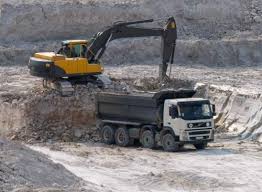Permission for mining or working of minerals
Mineral resources are natural concentrations of minerals or aggregates that, due to their inherent properties, are of potential economic value through mining and extraction. They are essential raw materials, upon which manufacturing, construction and agriculture rely.
In the UK, ‘minerals’ are defined in planning legislation as ‘all substances in, on or under land of a kind ordinarily worked for removal by underground or surface working, except that it does not include peat cut for purposes other than for sale.’
Schedules 5 and 9 of the Town and Country Planning Act 1990 establish a range of orders for mineral planning authorities to control minerals development.
The working of minerals can only take place if the operator has received both planning permission and any other relevant permits and approvals. These include permits from bodies such as the Environment Agency, licenses from Natural England, and so on.
There are a number of planning matters specific to the supply of minerals:
Firstly, minerals are only capable of being worked (i.e. extracted) in the place where they naturally occur in the sufficient quantity and of the desired quality, which means that there may be limited locations where economically viable and environmentally acceptable works can take place. This may impact on the permissions given to non-mineral development in areas where there are minerals, such as a defined mineral safeguarding area.
Permission often makes clear that the working of minerals is a temporary land use, albeit one that can take place over a long period of time. The fact that some minerals permissions can last for many years makes it necessary to carry out periodic reviews of the planning conditions attached to the relevant permission. This can help ensure that sites continue to operate in accordance with working and environmental standards.
Permissions are often given on the proviso that routine monitoring will take place, and permissions may stipulate that the land should be restored following working, to make it suitable for beneficial after-use. An example of this is the Eden Project in Cornwall, where a national educational and tourism resource was developed on the site of a former china clay pit.
In England, the key national planning policies for minerals are set out in the National Planning Policy Framework (NPPF), which aims to balance the sufficient supply of minerals with safeguarding against unacceptable adverse impacts.
In Wales, the land use planning policies for minerals are contained in the Planning Policy Wales, and supported by a series of Minerals Technical Advice Notes (MTANs).
In Scotland, mineral policies are contained in Scottish Planning Policy (SPP).
In Northern Ireland, policy and guidance is provided through the Strategic Planning Policy Statement for Northern Ireland (SPPS).
A Mineral Planning Authority (MPA) is a local authority with responsibility for mineral planning and for making permissions decisions. An MPA is the county council (in England, where there are two tiers of local government), the unitary authority, or a national park.
MPAs can plan for the steady and adequate supply of minerals by:
- Designating specific sites where development is likely to be acceptable in terms of planning and where landowners are supportive.
- Designating preferred areas where planning permission might reasonably be anticipated.
- Designating areas of search where the availability of mineral resources may be less certain but where planning permission may still be granted.
[edit] Related articles on Designing Buildings Wiki
- Development consent order.
- Dredging.
- Environmental Impact Assessment.
- Gypsum.
- Mineral planning authorities.
- Mineral safeguarding area.
- Minerals of local and national importance.
- National planning policy framework NPPF.
- Planning permission.
[edit] External resources
- BGS - Minerals UK
Featured articles and news
CIOB report; a blueprint for SDGs and the built environment
Pairing the Sustainable Development Goals with projects.
Latest Build UK Building Safety Regime explainer published
Key elements in one short, now updated document.
UKGBC launch the UK Climate Resilience Roadmap
First guidance of its kind on direct climate impacts for the built environment and how it can adapt.
CLC Health, Safety and Wellbeing Strategy 2025
Launched by the Minister for Industry to look at fatalities on site, improving mental health and other issues.
One of the most impressive Victorian architects. Book review.
Common Assessment Standard now with building safety
New CAS update now includes mandatory building safety questions.
RTPI leader to become new CIOB Chief Executive Officer
Dr Victoria Hills MRTPI, FICE to take over after Caroline Gumble’s departure.
Social and affordable housing, a long term plan for delivery
The “Delivering a Decade of Renewal for Social and Affordable Housing” strategy sets out future path.
A change to adoptive architecture
Effects of global weather warming on architectural detailing, material choice and human interaction.
The proposed publicly owned and backed subsidiary of Homes England, to facilitate new homes.
How big is the problem and what can we do to mitigate the effects?
Overheating guidance and tools for building designers
A number of cool guides to help with the heat.
The UK's Modern Industrial Strategy: A 10 year plan
Previous consultation criticism, current key elements and general support with some persisting reservations.
Building Safety Regulator reforms
New roles, new staff and a new fast track service pave the way for a single construction regulator.
Architectural Technologist CPDs and Communications
CIAT CPD… and how you can do it!
Cooling centres and cool spaces
Managing extreme heat in cities by directing the public to places for heat stress relief and water sources.
Winter gardens: A brief history and warm variations
Extending the season with glass in different forms and terms.
Restoring Great Yarmouth's Winter Gardens
Transforming one of the least sustainable constructions imaginable.
























